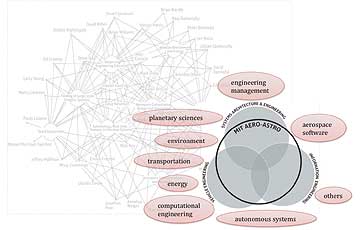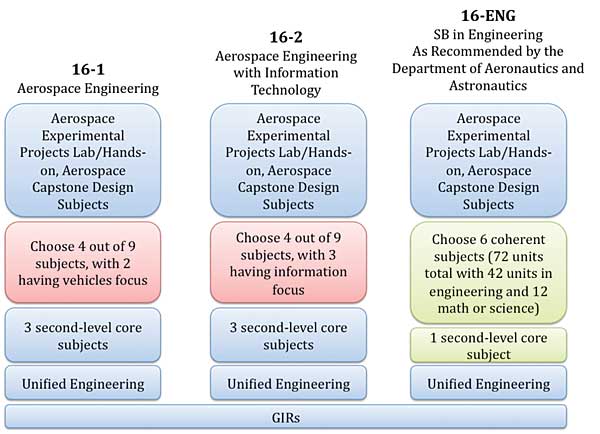|
AeroAstro Magazine HighlightThe following article appears in the 2009–2010 issue of AeroAstro, the annual report/magazine of the MIT Aeronautics and Astronautics Department. © 2010 Massachusetts Institute of Technology. |
||||||||
AeroAstro's strategic growth into systems architecture and engineering, and information engineering began around 1997. It led to an increased emphasis on interdisciplinary fields, such as computational engineering and engineering management, as well as multi-disciplinary fields such as energy and environmental studies. In the background is a connectivity map of the department's research thrusts and faculty. (enlarge image) |
 |
Since that time, aerospace engineering has continued to evolve; for example, the largest research areas in the department today are related to humans-in-loop autonomous systems, and energy/environmental matters associated with aviation.
This broadening of traditional engineering fields is not limited to aerospace engineering. National Academy of Engineering president and former MIT president Charles Vest says, "The last half of the 20th century was dominated by physics, electronics, high-speed communications, and high-speed long-distance transportation. It was an age of speed and power. The 21st century appears to be quite different, dominated by biology, structures, and information on a micro-scale, but also by macro-scale issues like energy, water, and sustainability." Vest adds, "Engineers will also face even larger challenges because the nation and world will need to call on them to seize opportunities and solve global problems of unprecedented scope and scale." With this breadth has come a blurring of boundaries among engineering disciplines, and between engineering and the physical and social sciences. Engineering graduates must be prepared for practice and research with broader interdisciplinary perspectives and greater understanding of the social, cultural, and political context of technological solutions.
Increased interest in multidisciplinary and interdisciplinary fields is also evident in recent surveys of MIT alumni and seniors. In the Class of 2005 Senior Survey, respondents indicated that effectively working on interdisciplinary engineering problems was important for their career plans (mean response of 5.9 out of 7, where 7=very important). However, this class was less positive about how its MIT engineering education had contributed to development of its interdisciplinary ability (mean response of 4.7 out of 7).
Enrollment in Mechanical Engineering's Course 2 and 2-A degrees show rapid growth in Course 2-A since its 2002 ABET accreditation. |
The rapid growth of the MIT Department of Mechanical Engineering's flexible undergraduate degree program, Course 2-A, offers more evidence of the demand for engineering degrees with increased multidisciplinary or interdisciplinary opportunities. The Course 2-A major is grounded in mechanical engineering fundamentals, but includes a concentration of six subjects to allow tailoring of an engineering degree to student interests. Students can design their concentrations, however, most choose pre-approved tracks that include: biomedical engineering; energy conversion engineering; engineering management; nano/micro engineering; sustainable development; control, instrumentation, and robotics. In fact, the Course 2-A degree has been offered since 1934, however, the rapid growth in enrollment only occurred after its 2002 ABET accreditation. In September 2010, the sophomore enrollment was more than 40 percent of the total sophomore enrollment in Mechanical Engineering.
To better understand the interest in awarding flexible engineering degrees in the MIT School of Engineering, seniors across the school were surveyed in 2009. Forty percent of the students expressed interest in such degrees, 30 percent were not interested, and 30 percent were not sure. Students who expressed an interest noted that it would expand their possibilities after graduation and would enable educational paths within MIT that are not possible now.

Comparison of AeroAstro's existing aerospace engineering degree programs (16-1 and 16-2) with the new flexible engineering degree program (16-ENG)
In 2007, a strategic planning effort lead by then Dean of Engineering Subra Suresh recommended developing flexible engineering degrees for students who wanted a multidisciplinary approach to their education without having to take additional classes on top of their already demanding course load. Suresh asked AeroAstro Department head Ian Waitz to lead a separate committee of six engineering department heads to explore this possibility. That committee unanimously proposed a schoolwide flexible degree program into which individual departments can choose to opt.
During the 2009 fall semester, AeroAstro began discussing a flexible engineering degree. Given the inherent interdisciplinary and multidisciplinary aspects of aerospace engineering, the development of a flexible degree in our department was given strong support from the AeroAstro faculty as an effective means to allow our students to explore a wide range of aerospace-relevant topics by leveraging the wealth of subjects available throughout the Institute. Continuing a tradition of leadership in educational innovation, AeroAstro was the first department in the School of Engineering to proceed with the development a new flexible engineering degree under the Dean's schoolwide initiative.
Working closely with colleagues from Mechanical Engineering — department head Mary Boyce, department associate head for education John Lienhard, and associate professor Peko Hosoi — we developed a flexible degree program, Course 16-ENG, along the same lines as Course 2-A.
Our department's work began with developing a learning objective for students in the 16-ENG program, specifically: the 16-ENG learning objective is for the students to develop understanding and skill in addressing multidisciplinary and interdisciplinary aerospace engineering problems. This is accomplished through developing a strong foundation within aerospace engineering, and then:
i also developing a greater understanding and skill in an interdisciplinary area relevant to aerospace engineering (e.g., energy, environment and sustainability, or transportation);
or
ii also developing a deeper level of understanding and skill in a field of engineering that is relevant to multiple disciplinary areas including aerospace engineering (e.g., autonomous systems, computational engineering, mechanics, or engineering management).
A set of predefined concentrations was developed for the 16-ENG rollout: autonomous systems, computational engineering, energy and environment, engineering management, and space exploration. We expect to develop additional concentrations in the coming years. As well, students have the option of developing their own concentration.
The 16-ENG curriculum is designed to offer flexibility within the context of aerospace engineering. This aerospace context is achieved in two ways:
These are essential elements of the MIT AeroAstro educational program. They also combine well with any number of aerospace-related concentration areas. The technical depth of the concentration areas is ensured in part by a requirement that of the 72 units in the concentration, 42 must be engineering and 12 must be math/science. We are excited about the educational opportunities brought by this new degree. Undergraduate students who pursue 16-ENG will receive a more multi-disciplinary or interdisciplinary engineering education, but one that still features the rigor and technical depth of the department's traditional aerospace engineering degrees.
16-ENG received official approval from the Institute's faculty in April 2010. Since that approval, we have been busy implementing the degree program. We have been collaborating with colleagues around the Institute to develop cross-school (e.g., computational engineering) and cross-Institute (e.g., engineering management, space exploration) concentrations. We expect our first 16-ENG students to graduate in June 2012, as some students have already transferred to the new flexible degree.
In embracing AeroAstro's 16-ENG, School of Engineering associate dean for academic affairs, and current interim dean of engineering Cynthia Barnhart said, "This culture of multi-disciplinary research is one of MIT's great strengths, and the flexible degree programs are simply another expansion of this culture into education." Attaining the new degree will be a challenging and rigorous task befitting of the challenge of our existing aerospace engineering degrees. It fits well with the MIT tradition of preparing the individuals who will tackle the world's most important, timely, exciting, and difficult problems and do so with enthusiasm and unparalleled ability.
 David L. Darmofal is a full professor and associate department head in the MIT Aeronautics and Astronautics Department. He is a member of the Aerospace Computational Design Laboratory. He is an Associate Fellow of the AIAA and an MIT MacVicar Faculty Fellow. He may be reached at darmofal@mit.edu
David L. Darmofal is a full professor and associate department head in the MIT Aeronautics and Astronautics Department. He is a member of the Aerospace Computational Design Laboratory. He is an Associate Fellow of the AIAA and an MIT MacVicar Faculty Fellow. He may be reached at darmofal@mit.edu
 Ian A. Waitz is the Jerome C. Hunsaker Professor and department head in the MIT Aeronautics and Astronautics Department. He is director of the Partnership for AiR Transportation Noise and Emissions Reduction (PARTNER). He is a Fellow of the AIAA and an MIT MacVicar Faculty Fellow. He may be reached at iaw@mit.edu
Ian A. Waitz is the Jerome C. Hunsaker Professor and department head in the MIT Aeronautics and Astronautics Department. He is director of the Partnership for AiR Transportation Noise and Emissions Reduction (PARTNER). He is a Fellow of the AIAA and an MIT MacVicar Faculty Fellow. He may be reached at iaw@mit.edu